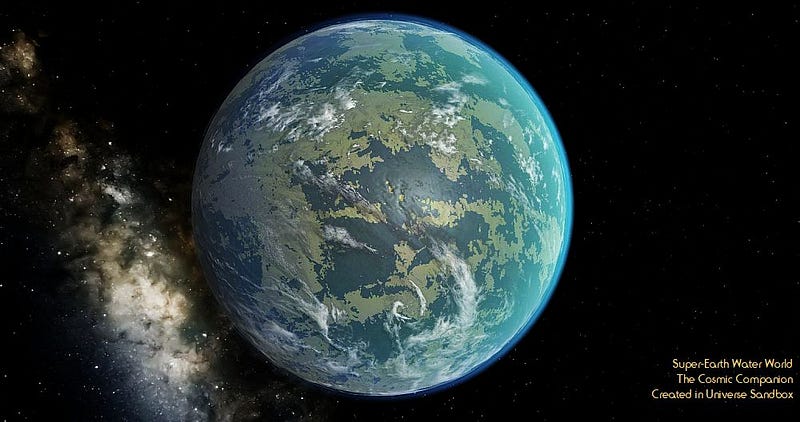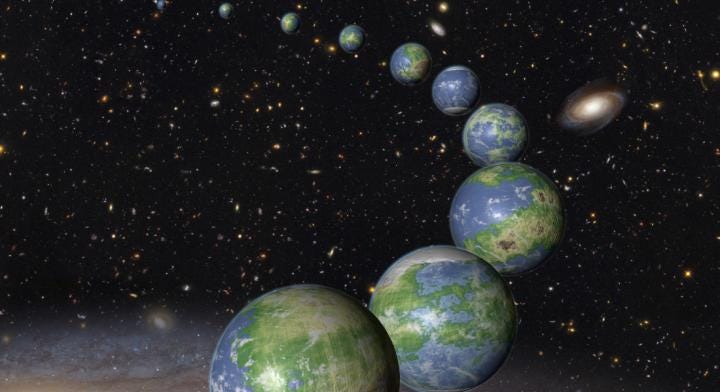Exploring the Possibility of Water Worlds in the Milky Way
Written on
The Prevalence of Water Worlds
Recent research indicates that the Milky Way might be teeming with water worlds. This finding stems from a study that investigates the formation of the inner planets within our own solar system. What implications does this have for the possibility of life beyond Earth?

The study posits that rocky, water-laden exoplanets could be more widespread than previously assumed. Currently, astronomers have identified over 4,400 exoplanets orbiting distant stars, with many potentially being water worlds. This conclusion arises from new insights into the formation of Earth and the other rocky planets in our solar system.
Approximately 4.5 billion years ago, the rocky planets may have formed from millimeter-sized ice and carbon-rich pebbles, which could have delivered water to these planets more efficiently than comets colliding with their surfaces. If verified, this theory could explain how Earth and Mars acquired substantial oceans shortly after their formation and suggests that water worlds might be common in the galaxy, enhancing the chances for life to emerge on these aquatic planets.
"All our findings imply that water was integral to Earth's construction from the very start. Given the frequent occurrence of water molecules, it's reasonable to assume the same applies to all planets in the Milky Way. The key factor for liquid water's presence is the distance of a planet from its star," explains Professor Anders Johansen of the University of Copenhagen.
The Formation Process
Computer simulations have modeled the early formation stages of Earth within the young solar system. These simulations indicate that as Earth, along with Mercury, Venus, and Mars, began to coalesce from tiny ice and rock pebbles, the resulting masses and orbits were consistent with a process known as pebble accretion.
This accretion process would have taken approximately five million years. During this time, Earth's surface temperatures escalated, leading to the evaporation of much water from the ice pebbles before they reached the surface. Consequently, our planet now contains only 0.1 percent water, despite this material covering 70 percent of its surface.

The Cosmic Connection
The exoplanets scattered across the Milky Way are likely composed of materials similar to those of our eight known planets and may have undergone a comparable formation process. This raises the possibility that water worlds are indeed common throughout the galaxy.
The first video, "Scientists Discover That Our Galaxy Is Full of Water Worlds," delves deeper into this phenomenon, offering insights into how prevalent these aquatic worlds might be.
"If our model holds true, all planets could possess comparable amounts of water, suggesting not only oceans but potentially continents similar to those on Earth. This could create favorable conditions for life to arise," explains Professor Martin Bizzarro, a co-author of the study.
If water predominantly arrived on planets through sporadic comet impacts, many would end up arid, reducing the likelihood of life, while others might be entirely submerged, facilitating the development of marine life. However, such conditions could hinder the potential for these lifeforms to explore beyond their aquatic environments.
Looking Ahead
The next generation of space telescopes, including the James Webb Space Telescope, aims to explore exoplanets for signs of water and potentially the first hints of extraterrestrial life.
The second video, "Q&A 161: Could You Have a Planet Made of Water? And More..." addresses fascinating questions surrounding the existence of water-rich planets and their implications for life.
James Maynard, the founder and publisher of The Cosmic Companion, resides in Tucson, Arizona, with his wife, Nicole, and their cat, Max.
Did you enjoy this article? Join us at The Cosmic Companion Network for our podcast, weekly video series, informative newsletter, and news briefings on Amazon Alexa and more!